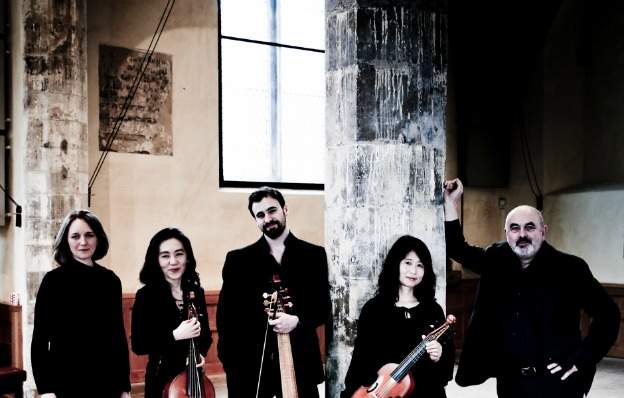
This hour on Harmonia, we finish up our 3-part celebration of the British-based viol consort Fretwork. In honor of its thirtieth anniversary, we're exploring Fretwork's experiences with 500 or so years of rich repertory, ripe for viols.
We heard a canon by J. S. Bach, from the recording Johann Sebastian Bach: The Art of Fugue, performed by Fretwork.
Music of J. S. Bach
Needless to say, the music of Johann Sebastian Bach has attracted musicians and audiences since the beginning of the early music revival. In 2002, Fretwork performed and recorded Art of Fugue, a Bach work based on a single theme. Let's hear a contrapunctus from Fretwork's 2002 Harmonia Mundi recording of Bach's Art of Fugue.
Later Richard Boothby arranged many of Bach's keyboard works from The Well-Tempered Clavier and the Clavierübung, released on the Harmonia Mundi label under the title Alio Modo. He would later go on to arrange the Goldberg Variations for viols.
Familiar Bach heard in a new way, here is his "Wenn wir in höchsten Nöten sein," BWV 641, composed for organ.
Fretwork's Newest Release
Between 2006 and 2011, the original ensemble of six gradually dwindled as family commitments, other professional engagements, and, alas, the very sad premature demise of Richard Campbell, intervened. By now, the second generation of Fretwork has even taken on a couple of third generation members, with the indefatigable original member Richard Boothby still leading the ensemble.
Fretwork still has wonderful repertory to explore and more appears all the time. Here is a special bonus for listeners of Harmonia, a first edit of the Fretwork CD scheduled to be released soon, but not yet available anywhere except here. This is a four-part fantasia in F by John Jenkins, one of the gurus of 17th century viol consort music.
Music of Orlando Gibbons
The thirtieth anniversary of the ensemble has inspired an ambitious project, the first recording of the complete verse anthems of Orlando Gibbons, which will be recorded in November of 2016 and released in the spring of 2017. Anthems that are well-known to many concert- and church-goers in a style very much influenced by the 19th century choral tradition will reappear in their private chapel settings, with one singer to a part and an emphasis on the rhetorical, dramatic expressiveness of music that passionately defends itself from the Catholic Counterreformation.
We end as we began with a piece by Orlando Gibbons, this one a very unusual combination of the "In nomine" idea we heard earlier in this series, with added street cries of early 17th-century London.
We heard "The Cry of London," by Orlando Gibbons, performed by Fretwork, from the 1989 recording Cries and Fancies.
2016-17 looks to be one of the busiest seasons ever for Fretwork, with the autumn including their longest yet tour to North (and indeed South) America, ranging from Bogotá to Boston, Montreal to Mississippi, with old and new music.
Wikipedia does not have much of the information that you have heard in these programs about Fretwork – at least not yet! What you have been hearing in these programs is in fact eyewitness recollections. Remember the transplanted American way back at the beginning of the ensemble? That would be me. In 2008, the demands of a full time university job in the US, combined with the increasing struggle required to take on the ever-more complicated world of travel and security intruded irretrievably on the idyll, but playing with Fretwork was absolutely central to twenty-two years of this viol player's life. My last concert with the band, at least until the 30th anniversary one in June 2016, had been on November 21, 2008, a run out from Bloomington, Indiana, to Stockholm, Sweden, leaving on a Thursday evening, back teaching on Monday morning. Lots of travel for a great couple of hours of music making…and time to let someone else have some of the fun.
The Hidden Face
Fretwork has, of course, for many years now, in addition to their meat and potatoes repertoire of 16th- and 17th-century consort music, regularly been involved in the development and performance of new music for viols. The 2001 recording The Hidden Face pairs music of 20th century British composer John Tavener with consort pieces by Tudor and Jacobean composers – including those of the 16th century English composer John Taverner, with whom the modern composer is sometimes confused!
Music from the 2001 recording John Tavener: The Hidden Face, performed by Fretwork.
Break and theme music
:30, J. S. Bach: The Art of Fugue, Fretwork, harmonia mundi 2002, Tr. 1 Contrapunctus 1 (excerpt of 3:09)
:60, Cries and Fancies, Fretwork, Virgin 1989, Tr. 6 Prelude and Ground for organ (excerpt of 3:18)
:30, Cries and Fancies, Fretwork, Virgin 1989, Tr. 19 In Nomine in 4 parts (excerpt of 3:28)
Theme: Danse Royale, Ensemble Alcatraz, Elektra Nonesuch 79240-2 1992 B000005J0B, Tr. 12 La Prime Estampie Royal
The writer for this edition of Harmonia is Wendy Gillespie.
Learn more about recent early music CDs on the Harmonia Early Music Podcast. You can subscribe on iTunes or at harmonia early music dot org.









